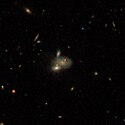NGC 4054
| Galaxie NGC 4054 | |
|---|---|
 | |
| SDSS-Aufnahme | |
| AladinLite | |
| Sternbild | Großer Bär |
| Position Äquinoktium: J2000.0, Epoche: J2000.0 | |
| Rektaszension | 12h 03m 13,1s[1] |
| Deklination | +57° 53′ 40″[1] |
| Erscheinungsbild | |
| Morphologischer Typ | 1: Sbc? 2: S0+? 3: SABc?[1] |
| Helligkeit (visuell) | 1: 14,4 mag 2: 15,0 mag[2] |
| Helligkeit (B-Band) | 1: 15,2 mag 2: 16,0 mag[2] |
| Winkelausdehnung | 0,6′ × 0,35′[2] |
| Positionswinkel | 1: 85° 2:144°[2] |
| Flächenhelligkeit | 1: 12,2 mag 2: 14,2 mag/arcmin²[2] |
| Physikalische Daten | |
| Zugehörigkeit | LDCE 856[1] |
| Rotverschiebung | 0.034148 ± 0.000018[1] |
| Radialgeschwindigkeit | (10237 ± 5) km/s[1] |
| Hubbledistanz H0 = 73 km/(s • Mpc) | (462 ± 32) · 106 Lj (141,5 ± 9,9) Mpc [1] |
| Durchmesser | 80.000 + 45.000 + 35.000 Lj |
| Geschichte | |
| Entdeckung | Wilhelm Herschel |
| Entdeckungsdatum | 17. April 1789 |
| Katalogbezeichnungen | |
| NGC 4054 • PGC 38078 • CGCG 292-062 • MCG +10-17-131 • IRAS F12006+5810 • VV 136 • GC 2682 • H III 794 • | |
NGC 4054 ist eine interagierende Galaxiengruppe, bestehend aus 3 Galaxien, im Sternbild Großer Bär am Nordsternhimmel. Die Galaxiengruppe ist schätzungsweise 462 Millionen Lichtjahre von der Milchstraße entfernt.
Das Objekt wurde am 17. April 1789 von Wilhelm Herschel entdeckt.[3]
Weblinks
Einzelnachweise
Auf dieser Seite verwendete Medien
Autor/Urheber: Sloan Digital Sky Survey, Lizenz: CC BY 4.0

Angle of view: 4' × 4' (0.3" per pixel), north is up.
Details on the image processing pipeline: https://www.sdss.org/dr14/imaging/jpg-images-on-skyserver/